(Update June 2024: I have written and visual evidence that neccesitates reworking all these images and text. The update will be on my research site soon.)
The mantua as often described is a garment with a very unique construction. It puts all the side skirt shaping on a single wedge of fabric, made of several widths of fabric, entirely in line with the front panels. The angled top edge lined up with the side of the back, the short piece (with the grain) in line with the front. This leaves the bottom of the piece to the hem that keeps the grain perpendicular to the floor no matter how long the train becomes.
To create my own pattern I collected and redrew every pattern of an extant garment published and redrew them to the same scale (1/4) and overlaid them to understand the interplay between each pattern piece. I ignored facings, cuffs, and petticoats and focused on the over garments.

Pattern type 1
A traditional method of dividing the side fullness between the front and back can be seen in the patterns of Albayzeta from 1720. Included are several “ropa de levantar.” The

edited from: Geometria y trazas pertenecientes al oficio de sastres ….
https://books.google.co.nz/books?id=LOPc3rKe1-gC
Juan Albayzeta
por Francisco Revilla, 1720 – 95 pages
This pattern is for a garment with a very long train, though there is also a secondary hemline drawn where the skirt back would just touch the ground- most of the patterns for “rope de levantar of this book are of the shorter type.

Of the extant garments that have been patterned the Danish gown most closely resembles this. It’s possible to find the parallel seams joining fabric widths as well as a seam between the two diagonal sides.

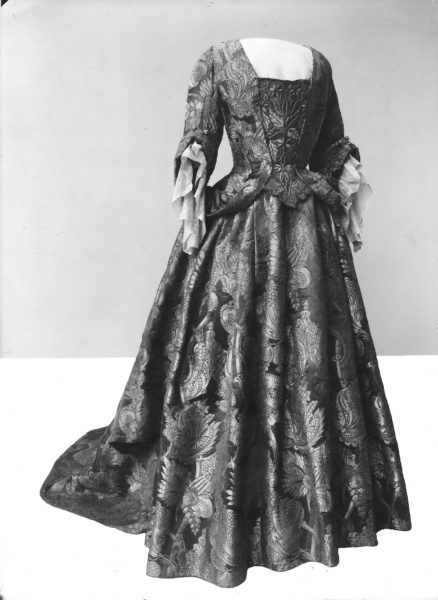

Moden i 1700-årene
https://www.worldcat.org/title/moden-i-1700-arene/oclc/835178454?referer=di&ht=edition
Author: Ellen Andersen
Publisher: [København] : Nationalmuseet, cop. 1977.
Series: Danske dragter

Moden i 1700-årene
https://www.worldcat.org/title/moden-i-1700-arene/oclc/835178454?referer=di&ht=edition
Author: Ellen Andersen
Publisher: [København] : Nationalmuseet, cop. 1977.
Series: Danske dragter
Pattern type 2
There is an open robe in Norway’s National Museum that is a single wedge each side but it is in line with the back panel.



Datering: Ca. 1720
http://samling.nasjonalmuseet.no/no/object/OK-dep-01160
Betegnelse: Drakt
Inventarnr.: OK-dep-01160
Eier og samling: Nasjonalmuseet, Designsamlingene
Foto: Nasjonalmuseet / Larsen, Frode Last ned.
The skirt is narrow and is worn with a very solid and full underskirt. This arrangement could mean the best display of the brocade pattern was at the side back.


Pattern type 3
Of the mantua type we are left with several garments in both English and American museums all with the wedge shaped piece matched to the front..
The earliest example appears to be the Kimberley gown held at the Metropolitan Museum in New York. The earliest date appears to be 1695.


Mantua
https://www.metmuseum.org/art/collection/search/81718
Date: late 17th century
Culture: British
Medium: wool, metal thread
Credit Line: Rogers Fund, 1933
Accession Number:33.54a, b
This garment has been pattern by both Nora Waugh and Blanche Payne, they differ slightly but the principle is the same and in both patterns the side fullness is entirely in line with the front panel.

The cut of women’s clothes, 1600-1930
https://www.worldcat.org/title/cut-of-womens-clothes-1600-1930/oclc/250274
Author: Norah Waugh; Margaret Woodward
Publisher: New York : Routledge : Theatre Arts Books, [1968] ©1968

History of costume, from the ancient Egyptians to the twentieth century. Drawings by Elizabeth Curtis.
https://www.worldcat.org/title/history-of-costume-from-the-ancient-egyptians-to-the-twentieth-century-drawings-by-elizabeth-curtis/oclc/1086817570&referer=brief_results
Author: Blanche Payne
Publisher: New York, Harper & Row [1965]
The next garment that has been patterned is from Shrewsbury c1710.

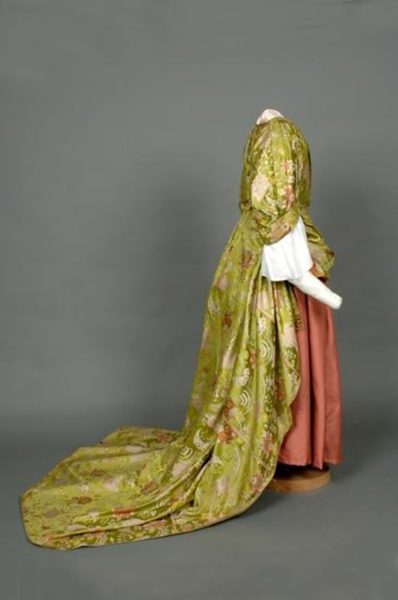
Mantua.18th century (1710). Shrewsbury Museums Service (SHYMS: T/1973/6/1). Image sy14193
http://www.darwincountry.org/explore/022360.html?ImageID=22370&Page=42#Gallery
This was patterned by Janet Arnold (Patterns of Fashion 1: Englishwomen’s Dresses and Their Construction C. 1660-1860).

Patterns of fashion. . 1. : Englishwomen’s dresses and their construction c.1660-1860.
https://www.worldcat.org/title/patterns-of-fashion-1-englishwomens-dresses-and-their-construction-c1660-1860/oclc/248594714&referer=brief_results
Author: Janet Arnold
Publisher: London : Macmillan, 1977.
I have divided the pattern so that the shapes can be compared more easily to the other garments- this garment has the sleeves cut with the body. The pattern can be easily put back as the dividing lines are the only diagonal lines in the draft.
Of special interest is the length of the front of the mantua. It is quite short (see image of overlaid pattern drafts.). Holme confirms that this is a common feature of mantua.
“A mantua is a kind of loose Coat without stayes [sic] in it, the Body part and Sleeves are of many fashions as i have mentioned in the Gown Body; but the skirt is sometimes no longer than the Knees, others have them down to the Heels. The short skirt is open before, and behind to the middle.”
The academy of armory, or, …
627-1699. https://quod.lib.umich.edu/e/eebo/A44230.0001.001/1:7.3.3?rgn=div3;view=fulltext
This next garment from 1720-1730 and is housed at the Museum of London and patterned by Zillah Halls in Women’s Costumes 1600-1750: London Museum. This garment is not currently digitised or on display.
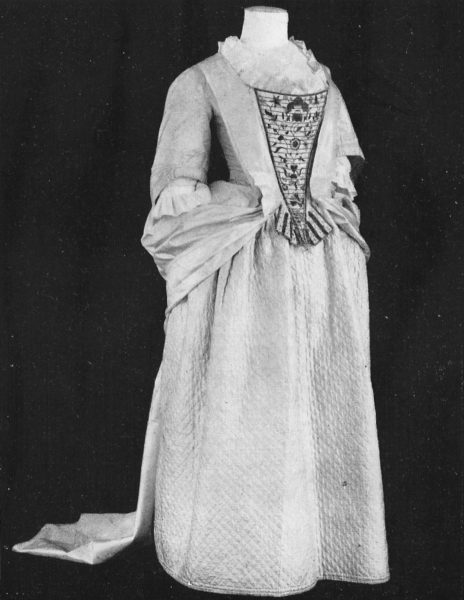

Women’s costumes 1600-1750,
https://www.worldcat.org/title/womens-costumes-1600-1750/oclc/49093
Author: Zillah Halls; London Museum.
Publisher: London, H.M.S.O., 1969.

Women’s costumes 1600-1750,
https://www.worldcat.org/title/womens-costumes-1600-1750/oclc/49093
Author: Zillah Halls; London Museum.
Publisher: London, H.M.S.O., 1969.
Another garment at the Museum of London was patterned by Nora Waugh, but not photographed. It is from 1735-1745 and uses the same construction. The train has been pinned up to the waist in the illustration but the pattern does not indicate any change in the construction.


The cut of women’s clothes, 1600-1930
https://www.worldcat.org/title/cut-of-womens-clothes-1600-1930/oclc/1074444804&referer=brief_results
Author: Norah Waugh; Taylor & Francis.
Publisher: Boca Raton, FL : Routledge, an imprint of Taylor and Francis, [2013]. ©1987.

The cut of women’s clothes, 1600-1930
https://www.worldcat.org/title/cut-of-womens-clothes-1600-1930/oclc/1074444804&referer=brief_results
Author: Norah Waugh; Taylor & Francis.
Publisher: Boca Raton, FL : Routledge, an imprint of Taylor and Francis, [2013]. ©1987.
And again this mantua is shorter at the front than the anticipated petticoat hemline (see image of overlaid pattern drafts.)
These are unfortunately the only garments with patterns I have been able to find but there are several more that have been catalogued and the skirt layout captured in photographs.
Manteau without patterns
The Metropolitan Museum has another early mantua example and the photographs do suggest the construction is of a kind- comparing the alignment of the pattern to the outside of the side back join in fabric shows it is in line with the hem not the seam.


Mantua
https://www.metmuseum.org/art/collection/search/81809
Date: ca. 1708
Culture: British
Medium: silk, metal
Credit Line: Purchase, Rogers Fund, Isabel Shults Fund and Irene Lewisohn
Bequest, 1991
Accession Number:1991.6.1a, b
A mantua in the Victoria & Albert Museum in London has been dated to 1733-1740 based on fabric (earlier date) and cut (later date). This gown has been photographed to show the construction of the skirt. This photo shows the brocade has been reversed from below hip level of the back panels and most of the side panels. This is so that only the face of the brocade is seen when worn and pinned in place.
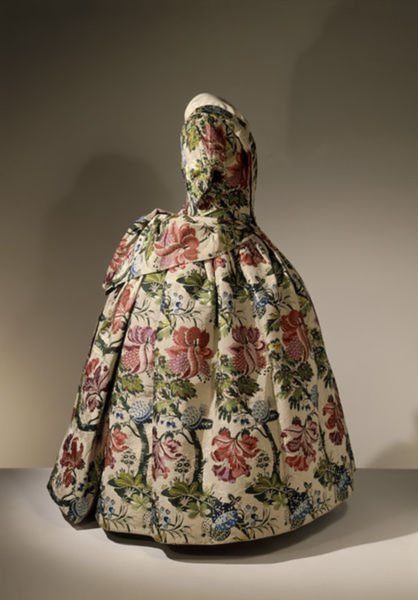


Mantua
http://collections.vam.ac.uk/item/O71872/mantua-unknown/
Place of origin:
Spitalfields (probably, woven) Great Britain (made)
Date: 1733-1734 (woven) 1735-1740 (made)
Artist/Maker: Unknown
Materials and Techniques: Brocaded silk, hand-sewn with spun silk and spun threads, lined with linen, brown paper lining for cuffs, brass, canvas and pleated silk
Credit Line: Given by Gladys Windsor Fry
Museum number: T.324&A-1985
The Lincolnshire Mantua has been dated to 1735 based on the fabric and over all pattern pieces. This particular mantua has the train and most side panels reversed so that when pinned for display only the face of the brocade is seen.
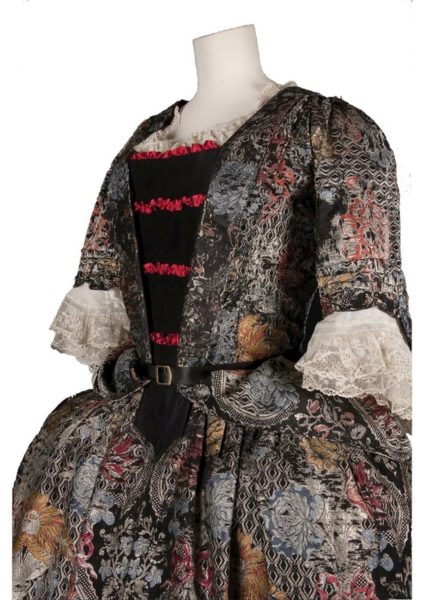



The Lincoln Mantua
https://www.lincolnshirelife.co.uk/posts/view/the-mystery-of-the-mantua
Mantua dated after these examples can be recognised by the folding of the train which follows the folding of the Lincoln mantua and the floral brocades mantua in the V&A as above.
One of the earliest is a blue silk mantua at the Victoria and Albert museum. From the 1720s it retains the extra length in the train despite being pinned up.


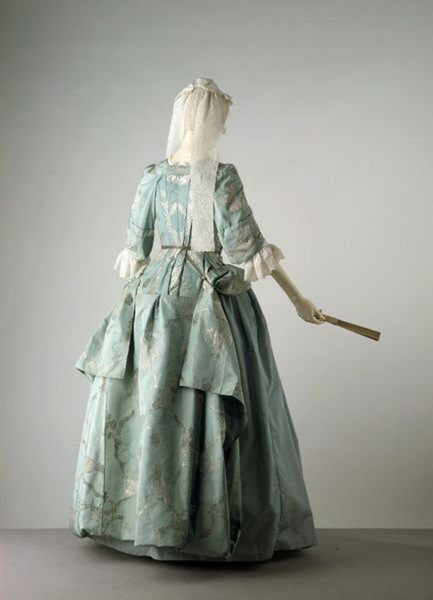
Place of origin: Spitalfields (textile, weaving) England (mantua, sewing)
http://collections.vam.ac.uk/item/O13810/mantua-unknown/
Date: ca. 1720 (weaving) 1720-1730 (sewing)
Artist/Maker: Unknown
Materials and Techniques: Silk, silk thread, silver-gilt thread; hand-woven brocading, hand-sewn.
Museum number: T.88 to C-19788
A brown brocaded silk mantua is also of this earlier type and is dated to 1732-1740.


Place of origin: Spitalfields (textile, weaving) Great Britain (ensemble, sewing)
http://collections.vam.ac.uk/item/O71535/mantua-unknown/
Date: ca. 1732 (weaving) 1735-1740 (sewing) 1870 – 1910 (altered)
Artist/Maker: Unknown
Materials and Techniques: Silk, silk thread; hand-woven brocade, hand sewn
Museum number: T.9&A-1971
Other garments described as mantua are harder to confirm from the photos.
The earliest is held at the Los Angeles County Museum of Art with a date of 1700. It is perhaps the most stunning example of its kind. A deep rich blue silk satin, the petticoat completely covered in metal embroidery, the sleeves and stomacher ditto, only the train seems to be more sparsely covered.

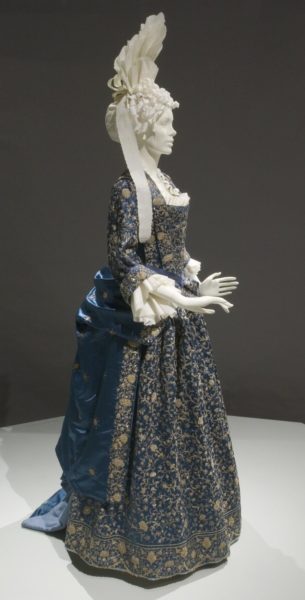

Woman’s Dress (Mantua) with Stomacher and Petticoat
https://collections.lacma.org/node/170609
Italy, circa 1700
Costumes; principal attire (entire body)
Silk satin with metallic-thread embroidery
Center back length (Dress): 67 in. (170.18 cm)
Length (Stomacher): 16 1/4 in. (41.28 cm) Center
back length (Petticoat): 41 3/4 in. (106.05 cm)
Costume Council Fund (M.88.39a-c)
A stunning embroidered mantua is held at the National Museum of Wales, dated to the 1720s though much of the train has been removed during the nineteenth century.


COLLECTION AREA mwl
https://museum.wales/collections/online/object/e2ce99c3-462b-3da3-af0a-953e4f94008d/Dress/?field0=string&value0=Tredegar&field1=with_images&value1=on&field2=string&value2=Dress&index=6
ITEM NUMBER 23.189.1
ACQUISITION Donation
MEASUREMENTS height (mm):1400 width (mm):2000 (max) depth (mm):1500 (max)
TECHNIQUES metal thread embroidery hand sewn weaving
MATERIAL damask (silk) metal thread silver parchment flax (spun and twisted) silk (spun and twisted)
LOCATION In store
CATEGORIES Court
A pale blue damask(?) mantua is held at the Manchester Art Gallery and appears to also be sewn so as to allow the face of the brocade to always be arranged outwards.

mantua dress
Acknowledgement: © Manchester
City Galleries
Created by:
Created: 1740-1742Another blue and silver mantua is held at the Kyoto Costume Institute and again has skirt panels reversed so as to always display the face of the brocade.
http://manchesterartgallery.org/collections/search/collection/?id=1989.220

Dress (Mantua) 1740-50s – England
https://www.kci.or.jp/en/archives/digital_archives/1700s_1750s/KCI_007
Material Blue silk taffeta brocade with botanical pattern, buttons to tack train; matching petticoat.
Dimension Length from the hips 183cm (Train)
Inventory Number(s) AC10788 2002-29AB
While this garment has been dated to the 1750s i believe it is somewhat earlier. The skirt as displayed does not fit well suggesting it was not worn over wide hoops. The train has been folded and appears to show the fabric has been reversed in a similar manner to the above folded mantua trains. So it could be 1720-1740.
A COURT MANTUA OF CHINESE IMPERIAL YELLOW SILK DAMASK, THE SILK CIRCA 1740, THE MANTUA 1750S
the bodice with long sweeping train of elaborately folded damask buttoning in swags onto two silk covered buttons at the small of the back, the bodice re pleated as a closed robe, the petticoats re-strung, shown here worn with a stomacher which is part of lot 141

